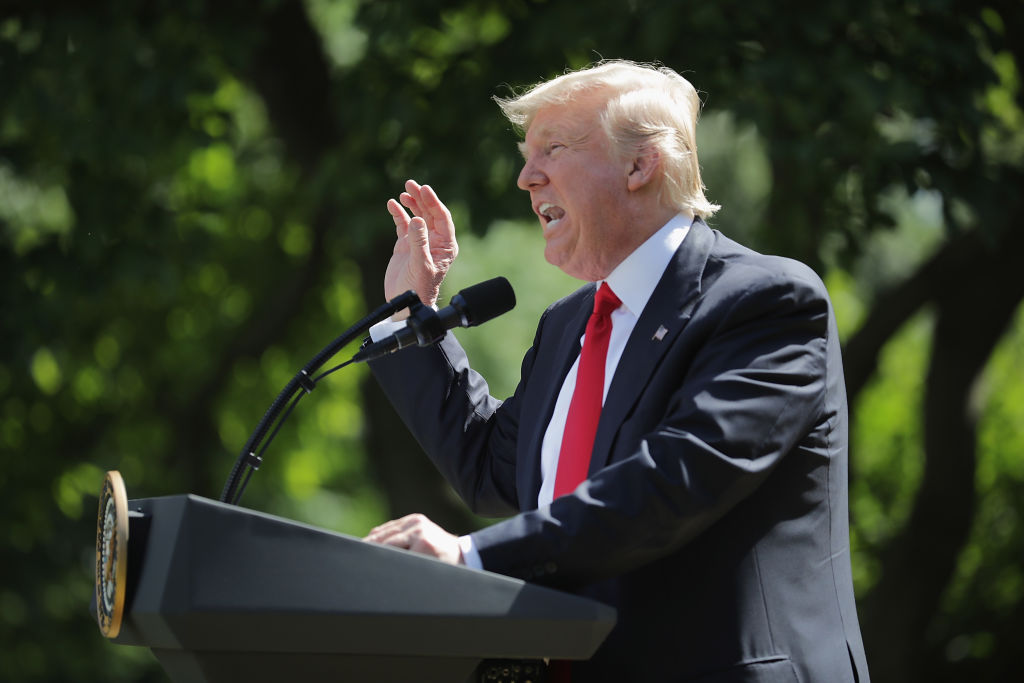Yesterday’s announcement by Donald Trump that the United States is withdrawing from the Paris Agreement is truly historic. The Paris accord was the closest the Europeans had come to getting the US to accepting timetabled emissions cuts in the now quarter century saga of UN climate change talks. The first was in the 1992 UN climate change convention itself, rebuffed by George H.W. Bush; the second was in the 1997 Kyoto Protocol, signed by the Clinton Administration, effectively vetoed by the Senate and repudiated by George W. Bush. Now, Donald Trump has dashed their hopes for a third and possibly final time. It’s understandable that the European reaction is one of fury and outrage.
In fact, Trump offered the Europeans an olive branch in renegotiating Paris or negotiating a new agreement. But within minutes of the president’s announcement, the leaders of Germany, France and Italy slammed the door shut on that, stating their belief that the agreement ‘cannot be renegotiated’. Brief though the rejection was, it is replete with the pigs-might-fly economics that characterises climate policy: imposing costs on the present creates opportunities for growth and prosperity, then pledging to compensate developing countries for slowing down their emissions. If cutting emissions creates wealth, why the need for hundreds of billions of dollars of climate finance?
In this respect, President Trump has a surer grasp of the economic realities than the Europeans. The United States is now the world’s hydrocarbon superpower. Thanks to fracking, it has surpassed Saudi Arabia and Russia to become the world’s top energy producer.

This abundance of hydrocarbon energy made the US the biggest loser from the Paris Agreement. Quitting Paris turns the US into the biggest winner from Paris – its access to cheap energy giving it a colossal competitive advantage in world markets as other nations increasingly burden themselves with high cost, unreliable wind and solar capacity.
Sanctimonious Europeans parading their moral superiority overlook Germany’s dirty carbon secret. The fall in German power stations’ emissions has stalled even as wind and solar capacity has increased. When Germany’s Energiewende first started, the Green energy minister promised it would cost the equivalent of a scoop of ice cream on monthly energy bills. A decade later, his Christian Democrat successor reckoned the cost at up to one trillion euros by the end of the 2030s. Indeed, the big falls in carbon dioxide happened in the wake of German reunification (cost: €1.3 trillion), another reason why Angela Merkel should be sending a large cheque to NATO.

If Europeans were truly motivated by concern about global warming, they would be extending the lives of their nuclear power stations and not bringing forward their closure, as Merkel is doing and President Macron looks likely to do with his appointment of the green activist and filmmaker Nicolas Hulot as energy minister.
Talk of America being cast into irrelevance by leaving the Paris Agreement ignores what happened after it rejected the Kyoto Protocol. By 2013 and the beginning of its second commitment period, the Kyoto Protocol had become an almost empty vehicle occupied mostly by Europeans and a handful of others. Post-Paris, America’s empty seat will become the most powerful seat as the US shows the rest of the world what energy freedom looks like, emboldening others to challenge climate policy orthodoxy. Prime among these is India, the other big loser from the Paris Agreement. With one fifth of the per capita electricity consumption of China, India’s electrification has a long way to go. As the world’s most populous country, India needs more coal-fired generating capacity, but reliance on solar and its destructive grid economics could set back Indian electrification for a generation.
Within the EU, the Visegrad Four (Poland, the Czech Republic, Slovakia and Hungary) are doing what they can to loosen the shackles of the EU’s Paris commitments. The wrangling arises because the EU’s commitment of a 40 per cent reduction on 1990 levels by 2030 is ‘to be fulfilled jointly’, individual targets not yet being parcelled out to member states. This leaves the UK in an interesting position: will the UK decide to be Good Europeans and impose even higher energy costs on its citizens and businesses or will it put the needs of the economy first?
Drilling of the Bowland shale formation, straddling the North West and South Yorkshire and containing 50 per cent more oil and gas than the two largest shale formations in the US, is about the start. There are also ample undersea reserves of coal under the North Sea. On this score, there is much to cheer in the Conservative manifesto with its commitment to fracking and its ambition that the UK should have the lowest energy costs in Europe. Perhaps that is why Angela Merkel bracketed the UK with the US in her post-G7 Taormina hissy fit about unreliable allies – a case of if it isn’t hurting, it isn’t working.
Rupert Darwall is the author of The Age of Global Warming: A History






Comments